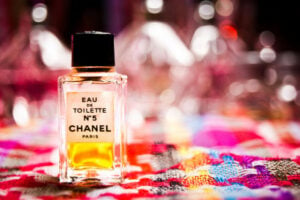Artificial Fragrances are Poison: 99 Reasons to Stop Wearing Perfume

We have a body odor problem in this country. But it’s not what you probably think. Yes, some of us stink pretty badly (thanks, Standard American Diet), but that’s not the problem. The issue is our relentless pursuit to cover up our body odor with artificial fragrances and perfumes.
Somewhere down the line we decided that detergents and chemicals smell more pleasant than our armpits. We traded in natural botanicals for hazardous materials. We let celebrities sell us perfumes because we think that’s what they must smell like all the time, and if we use their perfume, we’ll smell like a celebrity too.
While we’re now protected in most every public place from cigarette smoke’s hazardous effects, we have no protection against toxic fragrances. If you asked a flight attendant to reseat you because the person seated next to you reeked like Hannah Montana perfume, they’d smile apologetically. Yet fragrances pose serious health risks on par with cigarette smoke.
Think your Axe Body Spray is doing us all a favor? Think again. Here are 99 reasons to stop wearing artificial fragrances and perfumes.
- A single perfumed product can contain thousands of fragrances.
- And none of them have to come from a natural botanical source.
- So can: laundry detergent
- Antiperspirant
- Deodorant
- Shampoo
- Conditioner
- Lotion
- Soap
- Candles
- Skin care products
- Cleaning products
- Makeup
- And feminine hygiene products
- A self-regulated industry, manufacturers do not need to disclose these ingredients (they’re “trade secrets”).
- Fragrances contain phthalates.
- Phthalates have been linked to reproductive issues
- Early puberty in girls
- Organ damage
- Birth defects
- Immune response issues
- Endocrine disruption.
- Fragrances can cause headaches
- Mood swings
- Depression
- Anxiety
- Hyperactivity
- Brain fog
- Allergies
- Sore throat
- Watery eyes
- Eczema
- Rashes
- Coughing
- Asthma
- Erratic blood pressure
- Nausea
- Vomiting
- Abdominal pain
- And cancer.
- According to Dr. Mercola, synthetic musk, which is widely used in fragrances, can contain several harmful chemicals including:
- Xylene
- Ketone
- HHCB
- HHCB-lactone (the oxidation product of HHCB)
- AHTN
- Tonalide
- And galaxolide.
- Fragrances contain benzene.
- The American Cancer Society considers it a cancer risk.
- According to safe cosmetics, “one in every 50 people may suffer immune system damage from fragrance.”
- And “once sensitized to an ingredient, a person can remain so for a lifetime, enduring allergic reactions with every subsequent exposure.”
- Many fragrance ingredients are considered neurotoxins (damaging to the brain).
- Where there’s artificial fragrance, there are also parabens.
- Parabens can interfere with hormonal functions.
- They’re linked to cancer.
- And they may actually make your skin look older, faster.
- Dioxane is a common ingredient in detergents.
- Tests done on the popular Tide brand of detergent, showed that it contained 55 parts per million of dioxane.
- Levels as low as 5 to 10 parts per million have been shown to pose health risks.
- Dioxane even appears in some products labeled as “organic” or “natural.”
- Sodium lauryl sulfate (SLS) or sodium laureth sulfate (SLES), short for sodium lauryl ether sulfate, are common in fragranced products.
- More than 16,000 studies show that SLS in any form causes eye and skin irritation.
- And organ toxicity
- And neurotoxicity
- And developmental toxicity
- And reproductive issues
- And endocrine disruption
- And mutations
- …And cancer.
- NPE (nonylphenol ethoxylate) found in fragranced products has been linked to kidney damage.
- And liver damage
- And growth issues
- And metabolic issues
- And underdeveloped testicles
- And low sperm count.
- Fragrance-containing products are often tested on rabbits.
- And mice
- And rats
- And monkeys
- And cats.
- Our love for fragrances has an impact on the environment as well.
- Synthetic musk is accumulating in wild animals in toxic levels.
- Water filtration systems can’t remove some of the more toxic fragrance ingredients from our water supply.
- Some fragrances come from animals, taken in harmful ways.
- Amebergris comes from sperm whales.
- African Stone or Hyraceum comes from the hyrax (a very small, cute cousin to the elephant).
- Deer musk and civet cats are also exploited for their fragrance.
- Castoreum comes from the anal gland of a beaver.
- Fragrances don’t actually relieve your body odor problems anyway.
- They just mask it.
- Temporarily.
- Sometimes they just co-mingle with your body odor, making for very strange smells.
- Fragranced products cost you more money,
- While putting your health at risk.
- Fragranced products are often used to attract people, but the toxins can have the opposite effect…
- Repelling love interests.
- Making them feel sick. Literally.
- Even if they truly want to feel otherwise.
Keep in touch with Jill on Twitter @jillettinger
Resources
http://safecosmetics.org/article.php?id=222
http://www.huffingtonpost.co.uk/2012/01/12/paraben-chemical-linked-to-breast-cancer_n_1202144.html
http://functionaldiagnosticnutrition.com/laundry-detergents-pose-serious-health-risks/
http://davidsuzuki.org/issues/health/science/toxics/fragrance-and-parfum/
Related on Organic Authority
Detergent-Free All Purpose Surface Cleaner, DIY Style
19 Uses for Lavender Essential Oil
Make Your Own Essential Oil Sore Muscle Rub
Image: smailsareslimy

